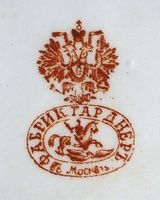Изготовитель Гарднеръ Фарфоровая фабрика
Купить фарфор Гарднеръ Фарфоровая фабрика мануфактура Гарднер. Продажа фарфоровых изделий на art-picture.ru
- Вначале высокая цена | низкая цена
Изготовитель Гарднеръ Фарфоровая фабрика мануфактура Гарднер

Фарфоровая фабрика «мануфактуры Гарднеръ» была основана в 1754 году англичанином Францем Гарднером и за более чем двухсотпятидесятилетнюю историю создала шедевры фарфорового искусства, ставшие украшением императорских дворцов России и Европы.
Фарфоровый завод Ф. Гарднера
История
Первый частный фарфоровый завод в России был основан в 1766 г. обрусевшим английским купцом Францем Яковлевичем Гарднером в селе Вербилки Дмитровского уезда Московской губернии. Для налаживания производства Ф. Гарднер пригласил работавшего на Императорском фарфоровом заводе И.-Г. Миллера, знакомого с рецептурой фарфоровой массы Д. Виноградова; подготовкой живописцев занимался приглашённый немец, художник по фарфору И. Кестнер.
В ранний период своей деятельности «Мануфактура Гарднера в Вербилках» выпускала изделия (посуду и фигурки) по образцам знаменитой Мейсенской фарфоровой фабрики.
В 1770-1780-е годы, по заказу императрицы Екатерины II, завод исполнил четыре Орденских сервиза (Георгия Победоносца, Андрея Первозванного, Александра Невского, Св. князя Владимира), предназначавшихся для торжественных приёмов кавалеров главных орденов России в Зимнем дворце. За высокое качество изделий в 1785 году московский губернатор присвоил предприятию «право на изображение Св. Георгия Победоносца в знак признания его Двором».
Фарфоровая мануфактура Ф. Гарднера являлась одним из лучших частных заводов в России. На протяжении XVIII-XIX вв. гарднеровский фарфор не только конкурировал с продукцией Императорского фарфорового завода, но оказал большое влияние на изделия многочисленных частных фарфоровых предприятий, став объектом для подражания. На фабрике вырабатывались фарфор, фаянс, опак, изделия из бисквитных масс. Основную долю продукции составляли чайные и столовые сервизы, штучная посуда, декоративные блюда, лотки, вазы, а также разнообразнейшая по тематике декоративная пластика. Мастера завода владели самыми различными приемами декорирования фарфора: подглазурной и надглазурной росписью, техникой печати, рельефа, изготовления пластических деталей. Необычайно широкой была тематика росписей: цветочные гирлянды и букеты, пейзаж и архитектурные виды городов, портреты героев войны 1812 г. и военные сюжеты, жанровые сцены и типажные изображения, монограммы и гербы дворянских родов. Источником многих сюжетов и изображений служили гравюры, различные книжные и журнальные издания.
В 1856 г. фарфоровый завод Ф. Гарднера получил звание поставщика Двора Его Императорского Величества, подтверждённое в 1865, 1872, 1882 и 1896 годах.
Вплоть до начала 1890-х годов завод принадлежал потомкам основателя производства. В 1892 г. предприятие вместе с заводскими моделями, формами, рисунками и образцами, а также с правом использования гарднеровской марки, было выкуплено М.С. Кузнецовым у последней владелицы Елизаветы Гарднер и преобразовано в «Товарищество производства фарфоровых и фаянсовых изделий М.С. Кузнецова».
После революции 1917 г. завод был переименован в «Дмитровский Государственный фарфоровый завод». В настоящее время предприятие носит название «Мануфактуры Гарднеръ в Вербилках» и является Почетным членом Гильдии поставщиков Кремля.

